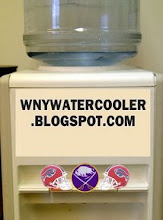Here’s a little Buffalo sports history: The Buffalo Braves started play as an NBA expansion team in 1970, the same year the Sabres joined the NHL. The Braves situation was unsettled from the start. The franchise was originally awarded to a group of investors headed by Phillip Ryan and Peter Crotty. When that group had problems in stepped local businessman Paul Snyder, who had sold his Freezer Queen company to Nabisco. The team’s general manager was Eddie Donovan, the former St. Bonaventure coach who had helped build the New York Knicks into an NBA champion as that team’s GM.
Buffalo struggled early, but things started improving when the team hired head coach Jack Ramsay in 1972. The emergence of the 1972-73 Rookie of the Year, Center Bob McAdoo, and the development of guard Randy Smith, a 1971 seventh round pick from Division III Buffalo State, keyed the improvement. In the 1973-74 season, bolstered by the addition of veteran forward Jim McMillan and rookie point guard Ernie DiGregorio, the Braves posted a winning record (42-40) for the first time and made the playoffs. (By the way, the Braves played some regular NBA season games in Toronto’s Maple Leaf Garden during that season). Buffalo then lost a highly controversial playoff series to the Boston Celtics, who went on to win the NBA title.
The Braves improved to 49-33 and made another trip to the playoffs in the 1974-75 season, as McAdoo won the MVP award (he averaged 34.5 points, 14.1 rebounds and 2.12 blocks per game). Buffalo’s attendance was good for that era, an average of 11,397 a game. The Braves lost a heart-breaking seven-game playoff series to Washington. After the season Donovan left the Braves and returned to the Knicks' general manager's post.
In the 75-76 season the Braves again made the playoffs with a 46-36 record, and knocked off Philadelphia in the first round of the playoffs. Unfortunately, Buffalo lost in the next round to Boston. The Celtics went on to win the NBA title. Shortly afterwards Ramsay left the team (“He wasn’t fired, he just wasn’t re-hired,” according to the Braves). Ramsay went on to coach Portland, taking a team that had never had a winning record to the 1977 NBA championship.
By then Snyder was clearly trying to sell the team. He argued that he had difficulty maximizing revenue because the Sabres and the local college teams controlled most of the best playing dates at the Aud. Snyder had worked out a deal with Irving Cowan, who intended to move the Braves to a new 15,000 arena in Hollywood, Florida, but the City of Buffalo was granted an injunction halting the move. Snyder eventually sold 50 percent of the franchise to businessman John Y. Brown, Jr., who had previously owned the Kentucky Colonels of the American Basketball Association. (Later Brown bought the other half from Snyder, and then sold part of the franchise to Rochester businessman, Harry T. Mangurian, Jr.). Few Buffalonians believed that Brown intended to keep the team in Buffalo.
A provision in the transaction stipulated that, if Brown sold the contract of any Braves player, the money would go to Snyder and the purchase price would be reduced. Not surprisingly, the Braves started losing some top talent. Buffalo acquired former ABA star Moses Malone, a future NBA MVP, but sent him to Houston after just two games. In the middle of the season, the Buffalo Braves traded McAdoo, a three-time NBA scoring champ, along with Tom McMillen to the New York Knicks for back-up center John Gianelli and cash. Attendance declined as the team got worse and questions about its future abounded.
One of the bright spots in the 1976-77 season was Adrian Dantley, who became the third Brave (following McAdoo and DiGregorio) to win the Rookie of the Year Award, but he would be traded the following season. The Braves again missed the playoffs in 1977-78, and the team’s poor performance, loss of star players, and uncertainty about the franchise’s future led to lower ticket sales. Even though the Braves’ home attendance fell to 6,258, Buffalo still outdrew Detroit and New Jersey.
The Braves had signed a 15-year Aud lease the previous year, but it contained an escape clause should season tickets drop below 4,500. On May 8, 1978 the inevitable happened: the Braves exercised their option to break the lease based on that clause. Brown looked at various cities he could move the team to, including Dallas, Minneapolis and Birmingham. Eventually he decided to negotiate a deal with the then-owner of the Celtics, Irv Levin, in which the owners would swap franchises. Brown liked the prestige of owning the Celtics, and Levin wanted to own a team in his native California. With the assistance of then-NBA general counsel David Stern, the complicated transaction was worked out. The Braves moved to San Diego and became the Clippers, and Brown and Levin exchanged franchises.




I can't believe it, but I actually agree 100% with Stephen A. Smith...
ReplyDeletehttp://sports.espn.go.com/broadband/video/videopage?categoryId=2378529&brand=null&videoId=3485388&n8pe6c=2
i run this bitc* and ima keep running... yo what up fans its your boy t wreck drinking a beer getting ready for the all star game and home run derby im gona do work thats for sure,, training camp coming soon unreal.. can trent be a leader in just his 2nd year in the nfl or does marv levy/ bill walsh have no idea what their talking about?? who will get the most playing time as the 2nd wide reciever behing number 83? where the f is jason peters wtf???? does turk have a damn clue? how many games will j p start this year?? how many albums will g unit sell?? jk we know the unit and wayne gona keep running never runnin outa money..
ReplyDeletehilarity from t wreck i missed it
ReplyDelete-steve